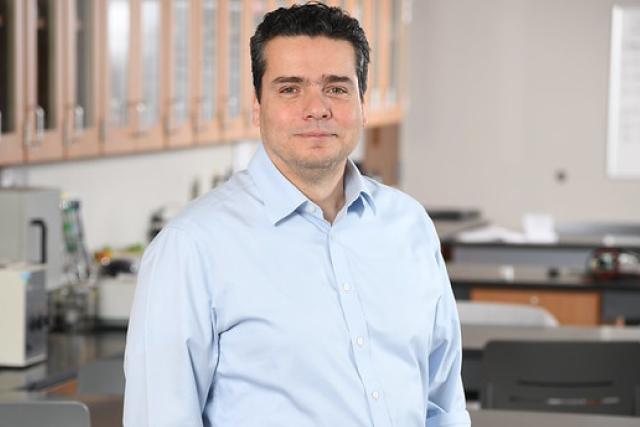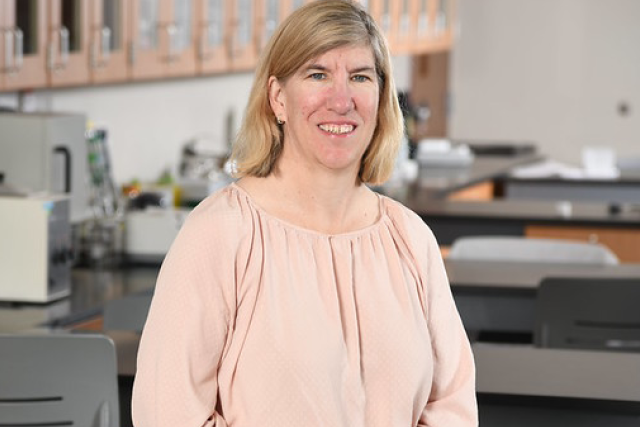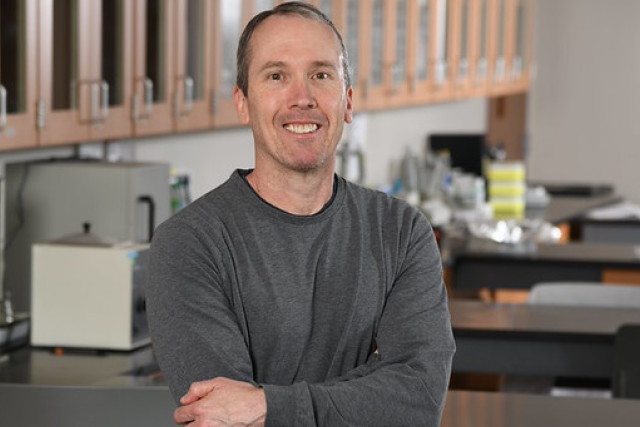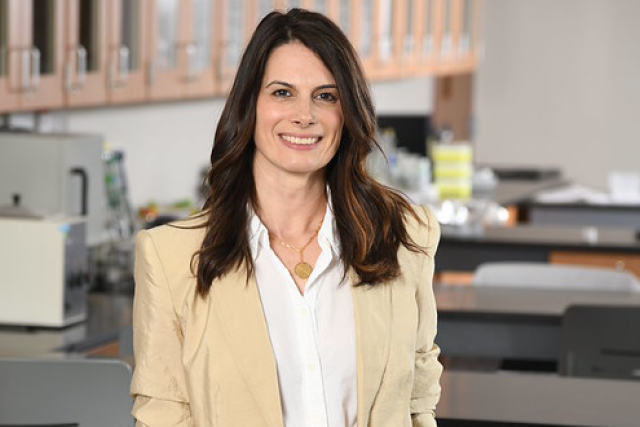The Loss Family Research Laboratory
Exploring the Impact of this Hub of Scientific Innovation and Student Engagement
Philanthropy has long played a role in expanding research at St. John Fisher University. Consider how the contributions of Janice Loss ’92 and the late Dr. Robert Loss ’74 have furthered scientific inquiry in the 21st century alone.
Dr. Loss, who graduated Magna Cum Laude from Fisher before attending medical school at the University of Rochester, was a member of the Board of Trustees for nearly 20 years. Janice Loss, who is the president and owner of Skin Search of Rochester, Inc. and DermaSpa, Partners of Dermatology Associates of Rochester, P.C., is currently a member of the Board.
In 2003, the Robert and Janice Loss Lecture Series was founded to promote the study of sciences among high school and college students. By 2017, another significant gift established the Loss Family Research Laboratory.
For more than two decades, the Loss family’s generosity has broadened access to research opportunities and enabled high-impact learning experiences for both students and faculty. Collegium sat down with four biology faculty members from the Life Sciences Division of the School of Arts and Sciences to learn more about their independent research, as well as how the lab has changed the way they teach and shaped their collaboration with students. This story is the second in a three-part series in 2025 shining a light on the evolution of research at Fisher.
Dr. Fernando Ontiveros
“I love this lab,” said Dr. Fernando Ontiveros, associate professor of biology.
A trained immunologist, Ontiveros has taken a multidisciplinary approach to research that blends his expertise with concepts and tools from the fields of bioengineering, cell biology, microbiology and remote sensing. He joined the Fisher faculty in 2012—five years before establishment of the Loss Family Research Laboratory which changed the way he taught and conducted his own research.
He acknowledges that having a dedicated space for research with students is a big advantage, especially the Loss Lab, which is designed like what one might find at a larger R1 research institution. His group works on three different research lines, and the space provides what he says is the “environment necessary for all three.” In fact, he notes, the lab has made it possible for faculty and students to enhance their research, thus allowing them to work on projects that before could only be done at R1 universities.
“The space encourages interactions between students carrying out different projects,” he said. “I have witnessed students working with other investigators walk over to observe their peers’ work and have conversations about their projects. The cell culture suite, for example, is used for several different research projects and for teaching a regular course. It really is state of the art, and students moving to bigger universities for graduate studies may even miss its convenient set up and ease of use.”
Ontiveros noted that his work with students has resulted in the development of a new platform for microfluidic devices, which has generated the submission of two provisional patents, and has earned the group the Trustees’ Distinguished Scholar award. It is also used in educational settings to conduct research projects.
Ontiveros maintains collaborative relationships at the University of Rochester and the University of Notre Dame, and has lately started a connection with researchers in Costa Rica for a potential Fulbright project. One lab project he led, the Space Bacteria project, was funded twice by the National Geographic Society.
“It is cool to have this internationally recognized organization support a long-shot project and have students be a part of it,” he noted.
Dr. Kathleen Savage
Dr. Kathleen Savage, assistant professor of biology, has a rich background in research. Prior to her arrival at Fisher, she spent five years in a post-doctoral research fellowship at the National Institutes of Health, training a president award-winning scientist, learning the latest biotechnology techniques, and investigating muscle growth. At Fisher, her research with students has one goal: to help make medical discoveries that improve lives.
For her, the lab is reminiscent of the one she worked in at the NIH, where having access to everything she needed in one place allowed her to maximize and prioritize time spent conducting research. Savage, who spends most of her time in the Cell Culture lab room in the Loss Family Lab, said that access and collaboration have become more seamless thanks to the space.
“The lab and ease of location allows me to assist students who are completing projects under the supervision of other faculty when the need arises, such as when the CO2 incubators gas cylinders need changing or they have a procedural question while their faculty advisor is teaching class,” she said. “It has allowed research students who are working on very different projects to learn and share ideas with each other in the same way as lab scientists for generations have done.”
One project conducted in the lab that stands out for Savage is an investigation of “muscle memory,” or long-lasting cellular adaptations to previous hormonal environment. “We study the cultured muscle cells following many generations with varying hormonal environments,” she said. “This project stands out because of the great discussions it has started regarding the impact of previous hormonal environments and muscle function.”
She adds that the lab’s location and the ease of access has greatly facilitated collaborations with colleagues and students from other departments, including chemistry and psychology.
Dr. Ed Freeman
Dr. Ed Freeman, professor of biology, agrees that the lab has increased the sense of community and collaboration for current and prospective science students, particularly for those interested in a research path at the undergraduate and professional levels.
“The lab is a very visible research space, shown on tours, of course, for prospective students to see,” said Freeman. “It is one thing to say we work with students on research projects and that all students are given the chance to conduct research, but to show a large, interdisciplinary space where the work occurs on a standard tour is fantastic.”
He said he enjoys the open nature of the lab—more work benches and fewer walls between neighboring labs—and how the space has allowed for more facilitation of interdisciplinary research. One example is a project with Dr. Ozge Kantas, professor of psychology, who reached out to Freeman and Savage to conduct salivary cortisol analysis for a breath work study using samples from students in one of her psychology lab courses.
“I’ve been very happy to see so many students across biology and chemistry experience the Loss Lab for both research and lab classes,” said Savage.
Freeman’s most memorable Loss Lab experience with a student occurred with 2020 graduate Maura Connorton, whose work inside the lab’s walls led her to write an external grant for $4,000 from the Endocrine Society. The grant provided funds to support Connorton’s research during the summer and academic year prior to her graduation, and allowed her to take part in a training program alongside “wonderful scientists that enriched her training experience.”
Dr. Jonelle Mattiacio
In addition to a courseload in biology, Associate Professor Dr. Jonelle Mattiacio also teaches nursing courses, including Microbes and Disease. With research interests in understanding virus-host interactions, she focuses on teaching students how to study and manipulate viruses in the Loss Lab Cell Culture room.
Most recently, Mattiacio and one of her students have been studying how viruses that infect bacteria (called bacteriophage) affect immune cells grown in the lab, specifically looking at macrophage and dendritic cells.
“Bacteriophage therapy is an approach that is being investigated as an alternative to antibiotics due to the high prevalence of antibiotic-resistant bacteria. Bacteriophages are not able to infect human cells, but more research needs to be done on the effects bacteriophage can have on the host immune response,” noted Mattiacio.
She and Ontiveros have developed an Advanced Cell course, centered around the Cell Culture room, which exposes a larger group of students to cell culture techniques, as well as the application of cells in nanobiology. Mattiacio also has collaborated with Dr. Kevin Callahan, associate professor of chemistry, to utilize the room for his Biochemistry II lab course—again, exposing a broader range of students to fundamental cell culture techniques.
Moving ahead, Mattiacio has developed a new section of the Biology Department’s Introduction to Research course, where students will investigate host factor proteins that interact with influenza virus polymerase complex, assisting in viral replication. Students will be able to investigate this question using only viral protein components and human or avian cells in culture, which she said is “all possible due to the cell culture space in the Loss Lab.”
The Future
As interest in the sciences at Fisher continues to grow, all four faculty members look forward to growth in research as well, anticipating that that Loss Lab will continue to be one of the most heavily used labs across the Life Sciences Division.
Freeman said that continued investment in the space will ensure that faculty will be able to keep science current for aspiring Fisher student scientists.
“I am hopeful that each of the users of the lab continues to work with student researchers and to write small grants to purchase supplies and equipment, as needed.”




